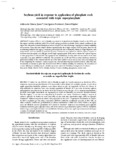Please use this identifier to cite or link to this item:
http://www.alice.cnptia.embrapa.br/alice/handle/doc/1003842| Title: | Soybean yield in response to application of phosphate rock associated with triple superphosphate. |
| Authors: | OLIVEIRA JÚNIOR, A. de  PROCHNOW, L. I.   KLEPKER, D.   |
| Affiliation: | ADILSON DE OLIVEIRA JUNIOR, CNPSO; LUÍS IGNÁCIO PROCHNOW, IPNI; DIRCEU KLEPKER, CPACP. |
| Date Issued: | 2011 |
| Citation: | Scientia Agricola, Piracicaba, v. 68, n. 3, p. 376-385, May/June 2011. |
| Description: | ABSTRACT: Soybean (Glycine max L. Merrill) crop started to be planted in the Brazilian Cerrado in the 1970's, and this region currently contributes with 57% of total soybean production in Brazil. Under natural conditions in this region, the soils present chemical limitations such as low pH, low Cation Exchange Capacity, low nutrient availability, and moreover, clayey soils have a high P fixation capacity mainly due to high contents of Fe/Al oxides. Since P is the most limiting nutrient is this region, a study was performed in the state of Maranhão, Brazil, in a Typic Hapludox, with clayey texture and low available P (extracted by resin). Treatments were defined to evaluate soybean response to broadcast Arad phosphate rock (PR) plus banded triple superphosphate (TSP) and to evaluate the soybean response to three proportions of PR and TSP. The experiment was established in October 2004 and was carried out for three consecutive crop years (2004/05 to 2006/07). The associated use of PR and TSP, in several situations, resulted in yields at least similar to that obtained with the use of the water soluble P source and, in some cases, even using lower P rates. Regarding the "mixtures", a linear response was observed when they were banded; however, when they were broadcasted, no increase in yield was observed above 50% of relative solubility. In conclusion, the association of sources differing in solubility may be a feasible agronomic option for P fertilizer management of soybeans. RESUMO: O cultivo de soja (Glycine max L. Merrill) na região do Cerrado iniciou-se na década de 1970 e, atualmente, representa aproximadamente 57% da produção total do Brasil. Sob condições naturais, os solos dessa região apresentam limitações químicas, como baixos valores de pH, de Capacidade de Troca de Cátions, de disponibilidade de nutrientes, bem como elevada capacidade de fixação de P nos solos de textura argilosa, principalmente pelos altos teores de óxidos de Fe/Al. Levando-se em conta que o P é o nutriente mais limitante à produção nessa região, foi instalado um experimento no estado do Maranhão, em Latossolo Vermelho-Amarelo distrófico argiloso e com baixo teor disponível de P (extraído com resina). Objetivou-se verificar a resposta da cultura à aplicação do fosfato de rocha Arad (FR) em área total mais superfosfato triplo (SFT) em aplicação localizada; e verificar a resposta da cultura a três proporções de FR e SFT. O experimento foi instalado em outubro de 2004 e conduzido por três safras consecutivas (2004/05 a 2006/07). A utilização associada de FR e SFT, em várias condições, resultou em produtividades no mínimo semelhantes à obtida com a fonte solúvel e, em alguns casos, até utilizando menores quantidades de P. Quanto às "misturas", verificou-se resposta linear para a aplicação localizada; entretanto, para a aplicação a lanço, não houve aumento na produtividade a partir de 50% de solubilidade relativa. Logo, a associação de fontes com solubilidades distintas pode ser uma opção agronomicamente viável para o manejo da adubação fosfatada da soja. |
| Thesagro: | Soja Cerrado |
| NAL Thesaurus: | Soybeans |
| ISSN: | 0103-9016 |
| DOI: | http://dx.doi.org/10.1590/S0103-90162011000300016 |
| Type of Material: | Artigo de periódico |
| Access: | openAccess |
| Appears in Collections: | Artigo em periódico indexado (CNPSO)  |
Files in This Item:
| File | Description | Size | Format | |
|---|---|---|---|---|
| Soybeanyieldinresponsetoapplicationofphosphaterockassociatedwithtriplesuperphosphate.pdf | 828 kB | Adobe PDF |  View/Open |









